From the Trenches
Port of the Pyramids
By ZACH ZORICH
Tuesday, April 08, 2014
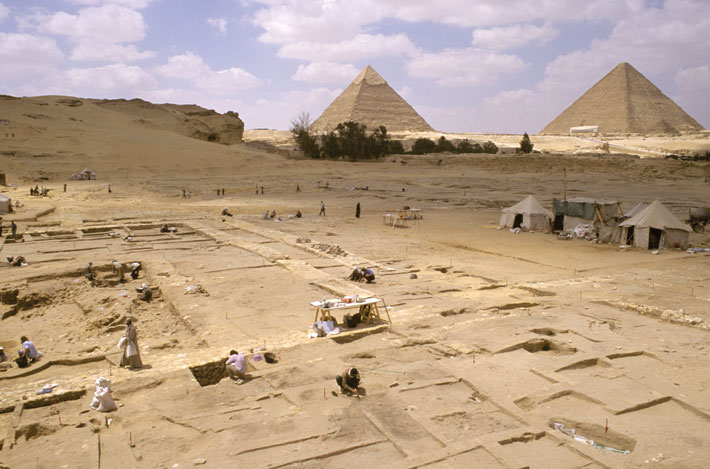
Sometimes great discoveries are made when archaeologists stop digging and take a closer look at what has already been found. This is what happened to Mark Lehner, director of Ancient Egypt Research Associates, as he was looking over maps of Heit el-Ghurab, where he has worked for 25 years. Lehner had thought that Heit el-Ghurab, a 4,500-year-old town next to the pyramids of Giza, was home to the workers who built the pyramids. But now he believes the town was also a wealthy Nile River port.
While examining the distribution of wood and pottery in a part of the town where laborers lived, Lehner recognized that much of it came from the Levant. He surmised that the laborers who built the pyramids were probably also sailors and that Heit el-Ghurab was probably the southern end of an important trade route called the Byblos Run, which brought lumber, olive oil, and other trade goods from territories as far north as modern-day Lebanon. “It’s a whole consilience of different lines of evidence that brought us to this aha moment,” says Lehner.
This rich port also had its own elite class. In the western part of the town, Lehner’s team found leopard teeth, which were worn as ornaments by certain Egyptian priests. The archaeologists also uncovered the bones of calves—veal would have been an especially prized luxury.
Off the Grid
By MALIN GRUNBERG BANYASZ
Tuesday, April 08, 2014
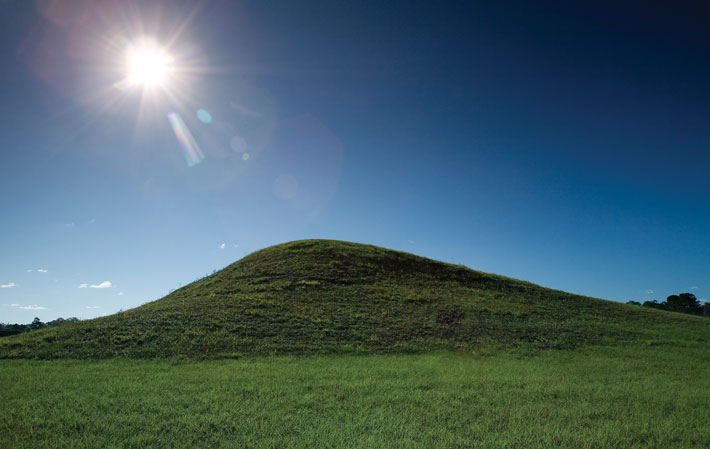
More than 1,200 years ago, a group of Caddo Indians called the Hasinai established a village in present-day Cherokee County, Texas, where they found good soil, a teeming forest, and nearby springs. Today the site, known as Caddo Mounds State Historic Site, is one of the best known and intensively investigated Native American sites in Texas. It is the southwesternmost ceremonial center of the Mound Builder culture, who flourished in the woodlands to the east from 1000 B.C. to A.D. 1550. The site was abandoned in the thirteenth century, but its spirit lives on in the modern Caddo Nation based in Oklahoma and in the name “Texas,” which comes from a Caddo word meaning “friend.” Archaeol-ogist Brett Cruse of the Texas Historical Commission says, “It was a major early Caddo center, and perhaps no other Caddo site has had as great an impact on what we know about them.”
The site
Visitors today can see three earthen mounds and a large portion of where the village was situated, estimated at more than 110 acres. Two mounds are platform temples that were used for political and religious ceremonies. The third is a burial mound containing several dozen tombs of community leaders, some of whom appear to have been accompanied by sacrifices. The associated village includes residences of common people, granaries, and garden plots. Archaeologists have learned a great deal about Caddo culture from excavations at the site. For example, residences in the village, dating to as early as A.D 850, were organized into compounds with small courtyards. The form persisted for several hundred years, demonstrating great continuity in Caddo community and social organization. Within special areas near the temple mounds, excavators have also uncovered evidence of a series of large public buildings that probably served as temples, council or clan houses, and perhaps residences of community leaders. Outside these areas were smaller houses that had been built and rebuilt in the same place for generations. A self-guided tour of the site can take about an hour, and there is a visitor’s center museum that exhibits about 200 artifacts, including pottery, tools, and weapons.
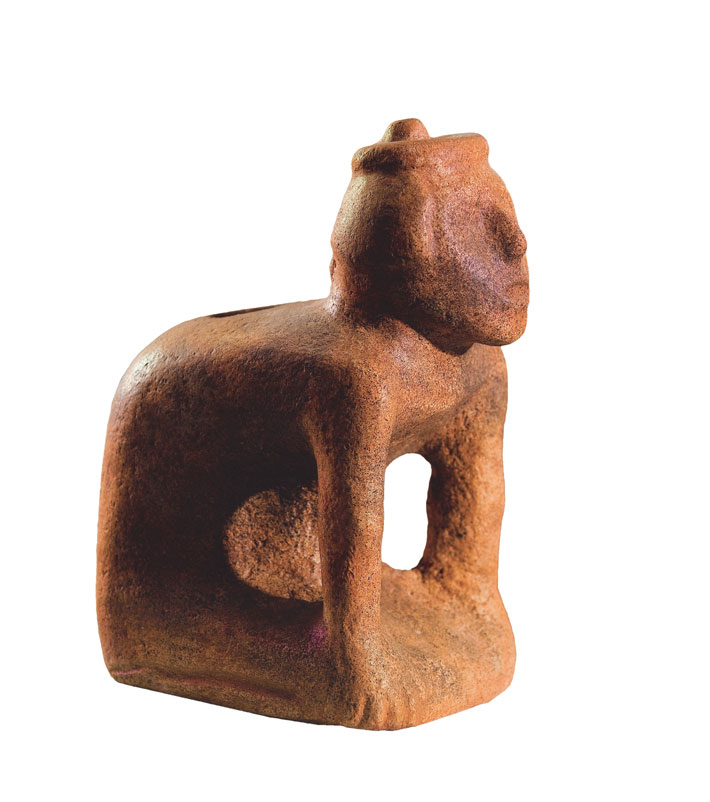
While you’re there
Six miles west of Caddo Mounds is Mission Tejas State Park, a 660-acre park with camping, hiking, and fishing, as well as a representation of Mission San Francisco de los Tejas, the first Spanish mission in the province of Texas, established in 1690. Just 18 miles away is a depot of the Texas State Railroad, which runs historic train engines and cars several days a week. The historic downtown of Nacogdoches, 26 miles away, offers several historical museums, food, shopping, and nightlife.
A Brief Glimpse into Early Rome
By JASON M. URBANUS
Tuesday, April 08, 2014
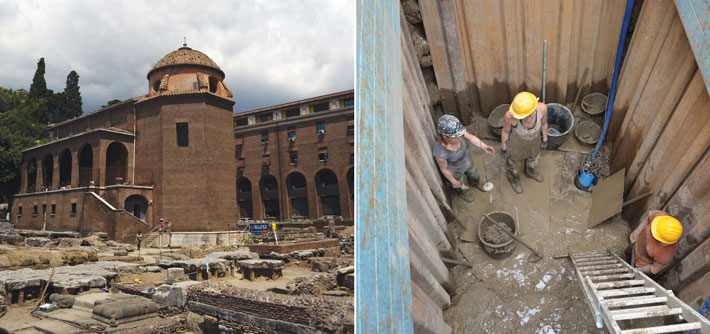
The Sant’Omobono archaeological site in Rome isn’t much to behold. It is strewn with a seemingly haphazard array of stone blocks, walls, ditches, and the occasional column drum—hardly pleasing to the eye. Even the eponymous Renaissance church that sits atop the site has been labeled as “incongruously ugly” by one prominent archaeologist. So it’s not surprising that tourists on their way to better-known monuments scarcely give it a second look.
This past January, however, the site suddenly received a great deal of attention when multiple international news sources reported incorrectly that Rome’s oldest temple had just been discovered there. As the archaeologists of the Sant’Omobono Project, an ongoing collaboration between the Superintendency of the Capitoline, the University of Calabria, and the University of Michigan, had actually made clear, this temple has been known—although rarely seen—since the 1930s, when it was first discovered.
Beneath Sant’Omobono lies a series of religious buildings that defined the site for much of the first millennium B.C. The importance of this area, situated at a bend in the Tiber River and known as the Forum Boarium, or “cattle market,” stemmed from its location at the nexus of several ancient communication and trade routes. It was the economic center of early Rome, complete with the city’s earliest river harbor capable of providing a safe haven for ships, and an international marketplace where goods, as well as cultural ideas, religions, and languages, were exchanged. It was also a prime location for the construction of a temple to protect and oversee this activity. “The [Sant’Omobono] site is crucial for understanding the related processes of monumentalization, urbanization, and state formation in Rome in the late Archaic period,” says Dan Diffendale, a member of the University of Michigan team. The site’s main archaeological features are the twin temples of Fortuna and Mater Matuta, which date to the late sixth or early fifth century b.c. Although these are among the oldest temple remains in ancient Rome, they actually sit atop an even older structure. This is the ancient Archaic period (roughly 800–500 B.C.) temple that January’s reports referred to.
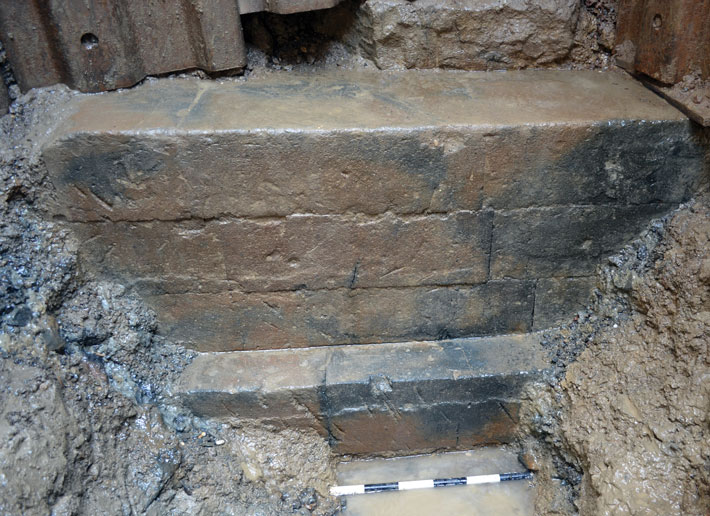 This structure has been notoriously difficult to evaluate, because it lies deep beneath the ground, well below the city’s water table. Now, however, the Sant’Omobono Project has finally been able to get a glimpse at the early temple’s foundation. In order to achieve this, steel retaining walls were hammered into the ground to hold back the weight of the waterlogged soil, and mechanical pumps were then used to drain the trench. At a depth of more than fifteen feet, three courses of stone blocks belonging to the ancient temple were identified. “We were able for the first time to record the Archaic foundation with modern means, using total station and photogrammetry, as well as extensive photography,” says Diffendale. “This is the first time that the Archaic podium has been exposed in relatively dry condition.”
This structure has been notoriously difficult to evaluate, because it lies deep beneath the ground, well below the city’s water table. Now, however, the Sant’Omobono Project has finally been able to get a glimpse at the early temple’s foundation. In order to achieve this, steel retaining walls were hammered into the ground to hold back the weight of the waterlogged soil, and mechanical pumps were then used to drain the trench. At a depth of more than fifteen feet, three courses of stone blocks belonging to the ancient temple were identified. “We were able for the first time to record the Archaic foundation with modern means, using total station and photogrammetry, as well as extensive photography,” says Diffendale. “This is the first time that the Archaic podium has been exposed in relatively dry condition.”
In addition, the Sant’Omobono team was able to recover hundreds of artifacts, including votive offerings, drinking vessels, and figurines. These suggest that the temple dates to the late seventh and early sixth centuries B.C., making these the oldest known temple remains in Rome. For safety reasons, the trench could stay open for only three days before it was backfilled. Nevertheless, this latest round of work will have long-lasting effects on archaeologists’ study of the development and growth of the eternal city. The Sant’Omobono site has finally gained its rightful place in the spotlight as one of ancient Rome’s most important, even if least well known, sites.
Advertisement
Advertisement
IN THIS ISSUE
From the Trenches
A Brief Glimpse into Early Rome
Off the Grid
Port of the Pyramids
Hardening Brittle Bones
First American Family Tree
Recreating Nordic Grog
The Goddess' Brewer
Peeping through the Leaves
Clash of the War Elephants
England's Oldest Footprints
Secrets of Bronze Age Cheese Makers
Our Lady of the Lake
Big Data, Big Cities
Advertisement

Recent Issues
-
 May/June 2024
May/June 2024
-
 March/April 2024
March/April 2024
-
 January/February 2024
January/February 2024
-
 November/December 2023
November/December 2023
-
 September/October 2023
September/October 2023
-
 July/August 2023
July/August 2023
-
 May/June 2023
May/June 2023
-
 March/April 2023
March/April 2023
-
 January/February 2023
January/February 2023
-
 November/December 2022
November/December 2022
-
 September/October 2022
September/October 2022
-
 July/August 2022
July/August 2022
-
 May/June 2022
May/June 2022
-
 March/April 2022
March/April 2022
-
 January/February 2022
January/February 2022
-
 November/December 2021
November/December 2021
-
 September/October 2021
September/October 2021
-
 July/August 2021
July/August 2021
-
 May/June 2021
May/June 2021
-
 March/April 2021
March/April 2021
-
 January/February 2021
January/February 2021
-
 November/December 2020
November/December 2020
-
 September/October 2020
September/October 2020
-
 July/August 2020
July/August 2020
-
 May/June 2020
May/June 2020
-
 March/April 2020
March/April 2020
-
 January/February 2020
January/February 2020
-
 November/December 2019
November/December 2019
-
 September/October 2019
September/October 2019
-
 July/August 2019
July/August 2019
-
 May/June 2019
May/June 2019
-
 March/April 2019
March/April 2019
-
 January/February 2019
January/February 2019
-
 November/December 2018
November/December 2018
-
 September/October 2018
September/October 2018
-
 July/August 2018
July/August 2018
-
 May/June 2018
May/June 2018
-
 March/April 2018
March/April 2018
-
 January/February 2018
January/February 2018
-
 November/December 2017
November/December 2017
-
 September/October 2017
September/October 2017
-
 July/August 2017
July/August 2017
-
 May/June 2017
May/June 2017
-
 March/April 2017
March/April 2017
-
 January/February 2017
January/February 2017
-
 November/December 2016
November/December 2016
-
 September/October 2016
September/October 2016
-
 July/August 2016
July/August 2016
-
 May/June 2016
May/June 2016
-
 March/April 2016
March/April 2016
-
 January/February 2016
January/February 2016
-
 November/December 2015
November/December 2015
-
 September/October 2015
September/October 2015
-
 July/August 2015
July/August 2015
-
 May/June 2015
May/June 2015
-
 March/April 2015
March/April 2015
-
 January/February 2015
January/February 2015
-
 November/December 2014
November/December 2014
-
 September/October 2014
September/October 2014
-
 July/August 2014
July/August 2014
-
 May/June 2014
May/June 2014
-
 March/April 2014
March/April 2014
-
 January/February 2014
January/February 2014
-
 November/December 2013
November/December 2013
-
 September/October 2013
September/October 2013
-
 July/August 2013
July/August 2013
-
 May/June 2013
May/June 2013
-
 March/April 2013
March/April 2013
-
 January/February 2013
January/February 2013
-
 November/December 2012
November/December 2012
-
 September/October 2012
September/October 2012
-
 July/August 2012
July/August 2012
-
 May/June 2012
May/June 2012
-
 March/April 2012
March/April 2012
-
 January/February 2012
January/February 2012
-
 November/December 2011
November/December 2011
-
 September/October 2011
September/October 2011
-
 July/August 2011
July/August 2011
-
 May/June 2011
May/June 2011
-
 March/April 2011
March/April 2011
-
 January/February 2011
January/February 2011
Advertisement






